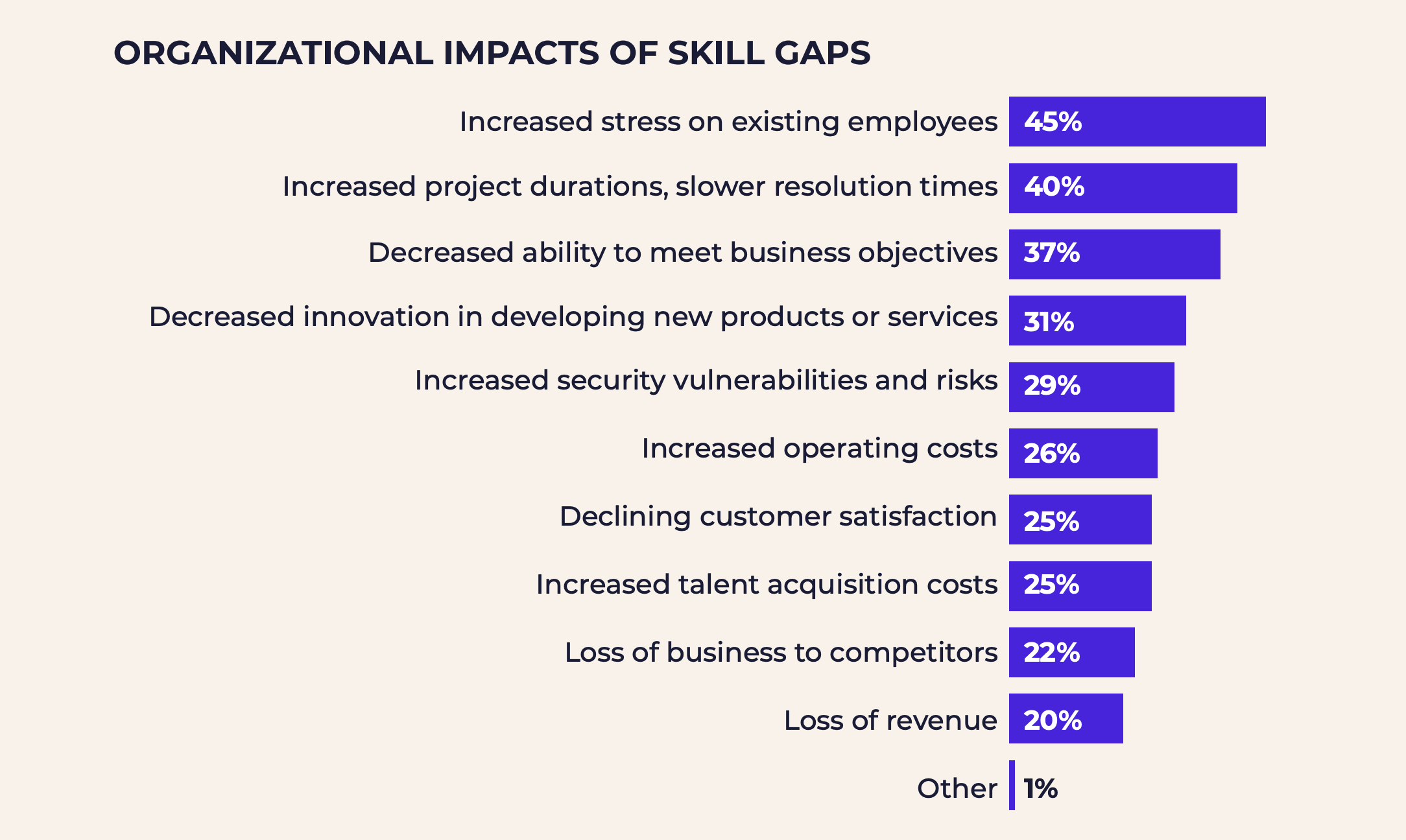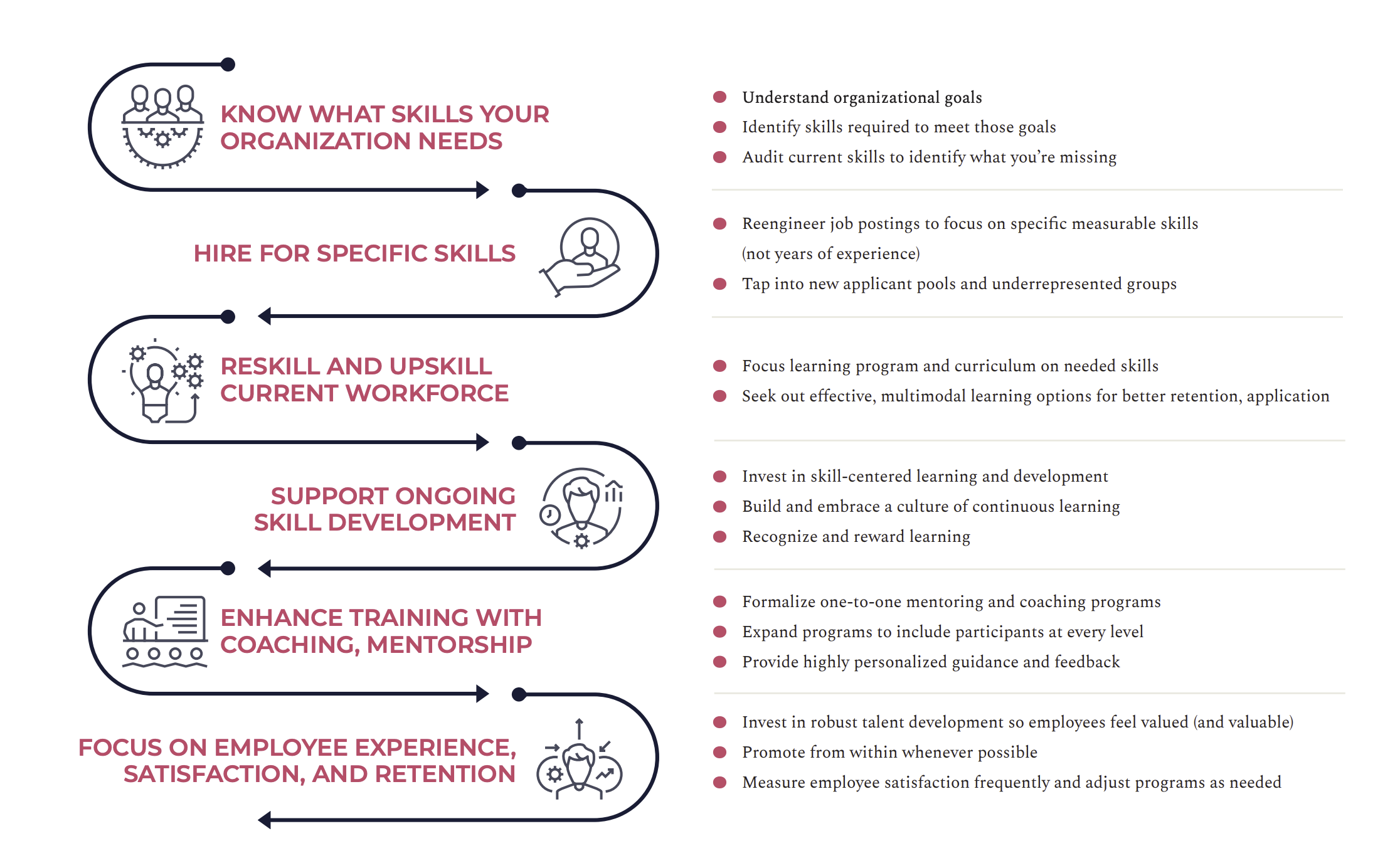Does Your LMS Integrate with Skillsoft?

Kate, a self-described artist, picked up coding after many years as a stay-at-home mom of three boys. Fast-forward to today, she's a full-stack software developer.
What sparked her journey to become a programmer started with a curiosity about how websites were made. "I went to the library and got a kid's book on HTML," she says. "And I was just curious."
Now, she works full-time as a programmer, poring over lines of Ruby or React. But it didn't happen overnight. It took a devotion to learning, fueled by a healthy curiosity, to get to where she is today.
In other words, Kate had a skills gap that she needed to bridge.
The skills gap refers to a discrepancy between the qualifications employers require and the abilities employees bring to the table. This makes it difficult for companies to find the right talent.
But a skills gap is less about a lack of ability and more about a goal. A skills gap is exposed when an individual or an organization wants to achieve a goal but doesn't have the capability today. Closing the gap requires learning or bringing in others to help accomplish the task at hand.
For individuals, skill gaps manifest like they did for Kate. Or Pablo, a QA engineer who upskilled from a role in customer service. Or Christine, who transitioned from a career in health care to becoming an associate software engineer.
Stories like these are becoming more common as people seek new career paths and show interest in developing their skills or advancing in their roles. However, much more significant issues also contribute to these shifts in how people work — most notably, ongoing technological advancements.
While tech stands to improve how people lead their lives at home and work, its efficiency impacts people's jobs, the economy, and so much else. AI, for example, has sparked a sharp demand in some jobs, like machine learning specialists, while also resulting in cutbacks of others.
The state of skill shortages globally is a compounding problem that has ramifications for both individuals and organizations of all kinds. And today, most organizations are grappling with them.
Read Next: How to Build a Vibrant Learning Culture in Your Organization
We will email when we make a new post in your interest area.
It's important to stress that skill gaps aren't a benign issue but furthering a global crisis that inspired the World Economic Forum's Reskilling Revolution, an ambitious mission to "prepare 1 billion people for tomorrow's economy and society." If left unchecked, global skill shortages could become a trillion-dollar problem.
Skillsoft's IT Skills and Salary Report has found that the pace of change in tech is the main factor. Others include a lack of investment in training, ineffective training programs, competition for talent, and attrition. While these are among the most common reasons, it's not an exhaustive list.

In tech, skill gaps are worst in areas like AI, cloud computing, and cybersecurity. However, the report shows that power skills are increasingly important, often serving as differentiators for prospective job candidates. Skills like leadership, project management, and others can make a big difference at work, but tech leaders recognize gaps in their teams in these areas too.
Regardless of where the gaps are, they take a toll on teams. The most common consequence of skill gaps is elevated stress levels among existing employees. Employees who feel stressed often miss more work — or quit altogether — and their productivity slumps.
Skill gaps have far-reaching, pervasive impacts on businesses. From project slowdowns to security vulnerabilities, these shortages create many roadblocks on the path toward progress.
However, the inverse can happen when individuals or organizations work toward bridging gaps. Employees often feel more engaged at work, they complete tasks faster, and morale jumps too. By addressing this challenge, organizations can solve several simultaneously.
"With societal unrest on the rise across much of the industrialized and emerging world, labour markets in flux from the fallout of the pandemic, technological disruption and the green transition, collaboration between the public and private sectors can advance an entirely different agenda, where people's futures and global economic prospects are enhanced by mobilizing worldwide mass action on reskilling, upskilling and education transformation."
– World Economic Forum on its Reskilling Revolution
When it comes to skill gaps, Skillsoft isn't exempt. Skillsoft shares many of the same needs as other companies that offer cloud-based solutions — reliability, efficiency, talent, and growth.
Within the past decade, Skillsoft has made significant strides in its goal of offering a modern solution to organizations that struggle with their own skill gaps.
But, we benefit from this work too.
Skillsoft has modernized its learning platform, Percipio, to remain competitive in the market, deliver a better experience, and scale to meet business needs. Transforming the company's software engineering discipline made this possible.
"Our enhancement efforts spanned numerous areas," says Murali Sastry, Skillsoft's SVP of Engineering and Cloud Operations. "Mastering new programming languages and process management, and revolutionizing our approach to platform hosting – upskilling was essential in every facet of our operations."
By reskilling and upskilling employees, the collective team earned dozens of AWS certifications, closed gaps in critical areas, and realized exceptional outcomes. Through this workforce transformation, Skillsoft cut 90% in recruiting costs, saved $5 million, and increased employee retention by 75%.
As Murali said, upskilling was essential to get these results. However, what that means and the approach can vary.
Read Next: Cloud Transformation: How Skillsoft Utilized its Learning Pathways to Upgrade its Capabilities
Many of Skillsoft's customers have transformed their workforces, spurred by a desire to reach new heights in safety, compliance, leadership, and technological innovation.
This includes Lexmark, which transitioned from a printing company to one that offers global imaging and Internet of Things (IoT) solutions. Lexmark's journey was an intensive yet fruitful endeavor to shift its culture and empower employees to become highly adept in leadership, diversity, equity and inclusion, and many technical areas. (Read that story here.)
DB Systel, a Germany-based rail business, struggled to source the talent needed, so it created a "Sprint Starter" program to upskill recent graduates. The program focused on onboarding employees and bridging gaps in the broader marketplace.
What these stories share with Skillsoft's and others' (perhaps yours) is that each path is unique. Even so, there are best practices to follow to help close gaps, like having a job architecture in place, encouraging learning, and making materials accessible.

As the world experiences continued skills disruption, talent development teams need to know what they're up against. Skillsoft's annual Lean Into Learning Report compiles insights to help optimize your upskilling strategy and provide more guidance on closing skill gaps.

